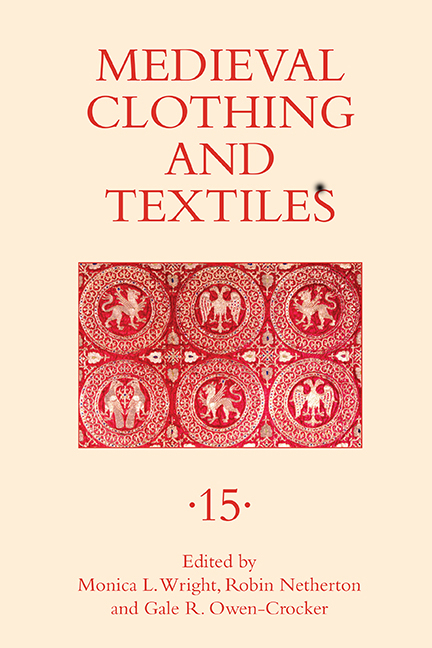Book contents
- Frontmatter
- Contents
- Illustrations
- Tables
- Contributors
- Preface
- 1 Old Rags, New Responses: Medieval Dress and Textiles
- 2 Text/Textile: “Wordweaving” in the Literatures of Anglo-Saxon England
- 3 Unfolding Identities: The Intertextual Roles of Clothing in the Nibelungenlied and Völsunga Saga
- 4 Clothing and Textiles at the Court of King John of England, 1199–1216
- 5 Dressing the Sacred: Medallion Silks and Their Use in Western Medieval Europe
- 6 Habit Envy: Extra-Religious Groups, Attire, and the Search for Legitimation Outside the Institutionalised Religious Orders
- 7 The Loom, the Lady, and Her Family Chapels: Weaving Identity in Late Medieval Art
- Recent Books of Interest
- Contents of Previous Volumes
7 - The Loom, the Lady, and Her Family Chapels: Weaving Identity in Late Medieval Art
Published online by Cambridge University Press: 31 March 2021
- Frontmatter
- Contents
- Illustrations
- Tables
- Contributors
- Preface
- 1 Old Rags, New Responses: Medieval Dress and Textiles
- 2 Text/Textile: “Wordweaving” in the Literatures of Anglo-Saxon England
- 3 Unfolding Identities: The Intertextual Roles of Clothing in the Nibelungenlied and Völsunga Saga
- 4 Clothing and Textiles at the Court of King John of England, 1199–1216
- 5 Dressing the Sacred: Medallion Silks and Their Use in Western Medieval Europe
- 6 Habit Envy: Extra-Religious Groups, Attire, and the Search for Legitimation Outside the Institutionalised Religious Orders
- 7 The Loom, the Lady, and Her Family Chapels: Weaving Identity in Late Medieval Art
- Recent Books of Interest
- Contents of Previous Volumes
Summary
In a late-fourteenth-century depiction of the Annunciation, painted around the apex of a triumphal arch, we see the Virgin Mary and Angel Gabriel kneel opposite one another with a vase of lilies placed in between (fig. 7.1). Their diaphanous robes are adorned with geometric patterns on the hems and necklines, down the seam from the elbow to the wrists, and on the cuffs themselves, with an additional rectangular panel attached to Gabriel's sleeve. These trims or borders might easily refer to the practice of stamping gold or silver onto cloth or the stitching of ribbons woven with gold onto garments that visually conferred dignity and status upon the displayed body. In this case, that body was the receptacle for Christ, the woman who would become the vehicle for the salvation of humanity.
The Virgin kneels at a simple domestic prie-dieu that displays an open book. Mary had been reading up until the point of angelic interruption. Two text boxes are precisely ruled in black across the double spread of the book, and they each contain lines of large, loosely described letters. In the little cupboard of the prie-dieu, there is another small book of prayer owned by the Virgin, reinforcing the message about containment and incarnation, about divinity in the making, as well as private devotion. This is made all the more clear in the vignette set to the far left of this biblical episode. Behind the Virgin there is a plain chest, a wooden chair set with a blue and red checked fabric seat, and an upright weaving loom. They are items of domestic furniture that illustrate the Virgin's devotional life and activities, but they also are identifiable with the furnishing of a contemporary home of a well-to-do woman. The compositional layout of the scene thus makes clear that before taking to her knees in prayer, the Virgin had been seated on the chair working at the loom; and it is here that matter becomes material.
The loom is strung with vertical threads from the beam in colours of red and silver (fig. 7.2). A fabric is visible from the bottom to the midway point, where the threads have been pushed down, compacted, by the application of the horizontal shuttle that weaves between the threads creating the warp-and-weft effect of a decorative textile.
- Type
- Chapter
- Information
- Medieval Clothing and Textiles 15 , pp. 157 - 182Publisher: Boydell & BrewerPrint publication year: 2019

